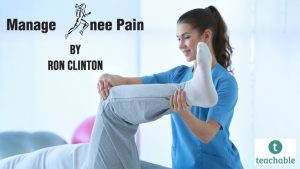Self-Manage Knee Pain

Take The Self-Manage Knee Pain Course
In this comprehensive Self Manage-Knee Pain Course (based on the booklet: Self-managed Knee Pain: Tips, Strategies and Exercises Before Injections or Surgery), you are provided with 8 different sections, 17 different modules and more than four and a half hours of content.
Included are many video demonstrations of exercises and strategies that have worked very well for many of my clients as well as hundreds of other clients who are treated with the directional preference assessment and treatment approach.
The content provided is evidence-based and current. You are given clear instructions to guide you through a potentially life-changing experience.
Some knee pain providers want you to start with more expensive programs that have little evidence to support them. Other providers want to do invasive techniques (shots/surgery) before trying conservative methods as taught in this course.
Here are the Objectives for Each Module of the Course.
Module 1
A. Understand the knee pain vicious cycle.
B. Realize that knee pain not resolved quickly triggers a series of unfavorable events.
C. Learn why less steps per day, weight gain, more need for medication, loss of strength and inflammation lead to more of the same.
Module 2
A. Learn why worldwide research and treatment guidelines support learning self-management skills to manage chronic knee pain.
B. Learn how this builds confidence to manage your pain and not be managed by it.
Module 3
A. Learn why imaging tests (x-rays and MRIs) are a picture in time and should only be a part of the decision making process regarding your knee treatment.
B. Learn why you need to understand the role of inflammation in knee pain.
Module 4
A. Learn the stunning limitations and risks associated with over-the-counter medications, opioids, injections and surgery.
Module 5
A. Learn additional helpful information to self-manage and control inflammation.
B. Learn about research regarding the best diets to reduce inflammation or aggravation of the knee.
Module 6
A. Learn strategies to break the vicious cycle of unfavorable events caused by knee pain.
Module 7
A. Learn easy to implement self-management interventions.
B. Identify the importance of self-management. This module provides practical examples and suggestions.
Module 8
A. Learn lifestyle modification and principles for managing daily activities and protecting the knee.
B. Learn simple changes you can make to lesson pain and increase function.
Module 9
A. Learn how professional guidance and consultation can enhance your ability to self-manage knee pain.
B. Learn how to choose the most conservative, cost-effective and evidence-based program.
Module 10
A. Learn why your knee pain may not be a knee problem.
B. Learn how to do self-assessment to determine if the spine could be involved with your knee pain and decreased function.
C. Learn the possibilities for improvement from actual case studies.
Module 11
A. Learn how to self-assess your knee and determine if you have a directional preference of movement.
B. Learn specific directional preference exercises.
Module 12
A. Learn why exercise for the knee or spine is like a medication. Learn the importance of dose frequency and timing, et cetera.
B. Learn why every self-treatment program will be an individual program with a combination of exercise, daily activity modification, and specific self-management strategies.
C. Learn exercise guidelines.
Module 13
A. Learn key lower extremity strengthening exercises-an important factor in determining long-term success.
B. Learn hip exercises that are helpful for knee issues.
Module 14
A. Learn guidelines for strategic and safe walking without flaring up your knee.
B. Learn how to deal with limping or slowed down walking secondary to knee pain.
Module 15
A. Learn how a stress-reducing exercise can be an important piece of your holistic plan to self-manage pain in the knee and other areas of the body.
B. Identify if running can or should be on your list of exercises.
Module 16
A. Learn how professional guidance from a physical therapist, in conjunction with self-management strategies learned in this course, can help you achieve another level of success.
B. Exhaust all conservative strategies before letting any practitioner stick needles, scopes or blades into your knee.
Module 17
A. Identify and outline your unique, personal “(jigsaw puzzle”) plan based on the self-assessment and guidelines presented in this course.
B. Use the “Afformation” approach to document your plan.
C. Refer to your plan and carry out your plan on a daily basis.
D. Stick with your plan and seek consultation with a physical therapist if needed.
